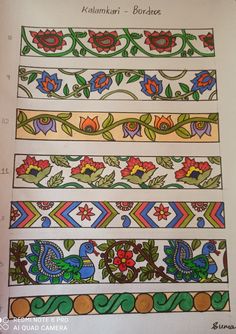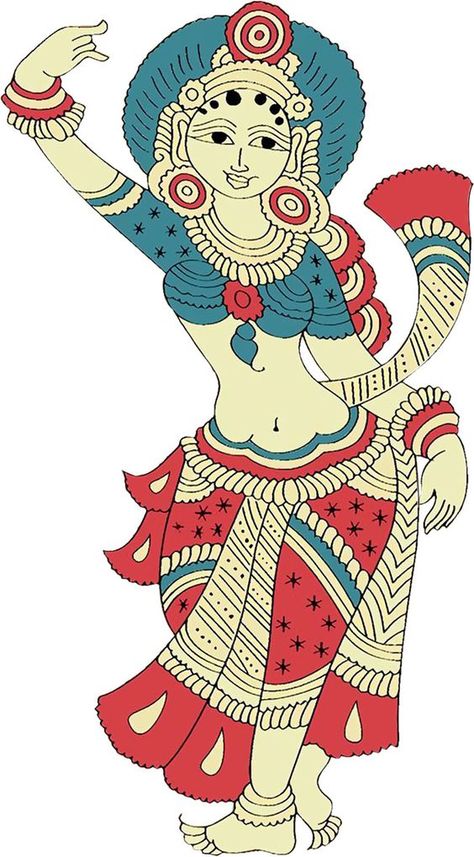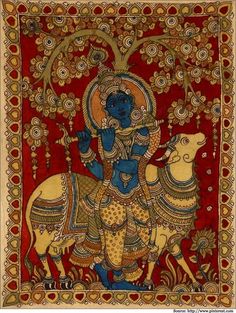Kalamkari Design 03
Kalamkari art is a traditional Indian textile craft known for its intricate designs and vibrant colors, characterized by hand-painting and block-printing techniques. Originating primarily from the Indian states of Andhra Pradesh and Telangana, this art form has a rich cultural and historical background, deeply intertwined with Indian mythology and spirituality. The word “Kalamkari” literally translates to “pen work,” referring to the tool used to create intricate designs on fabric. This overview delves into the history, techniques, themes, and contemporary significance of Kalamkari art.
Origins of Kalamkari

Kalamkari has ancient roots, with references in texts dating back to the Mahabharata and Ramayana. It flourished during the Mughal era, when artisans began to experiment with fine brushes and natural dyes to create detailed images on textiles. Historically, Kalamkari was used for temple hangings, clothing, and decorative pieces, serving both aesthetic and religious purposes.
Cultural Significance
Kalamkari is closely associated with Indian culture and spirituality. The art often depicts mythological figures, deities, and stories from epics, playing an important role in rituals and celebrations. The textiles produced not only serve as decorative items but also as a means of storytelling, preserving cultural narratives and traditions.
Techniques of Kalamkari
Kalamkari employs two primary techniques: hand-painting and block-printing.
Hand-Painting
In hand-painting, artisans use a tamarind stick, sharpened to a point, dipped in natural dyes to meticulously draw designs on fabric. This technique allows for fine details and complex imagery, often requiring several days to complete a single piece. The use of natural dyes, derived from plants and minerals, enhances the vibrancy and longevity of the colors.
Block-Printing
Block-printing involves carving intricate designs into wooden blocks, which are then dipped in natural dyes and stamped onto fabric. This method allows for the efficient production of repeated patterns. Each block is carefully aligned to ensure consistency, and artisans often incorporate both techniques in their work to create diverse designs.
Dyeing Process
The dyeing process in Kalamkari is labor-intensive and involves multiple steps:
- Preparation: Fabrics are pre-treated to ensure the colors adhere well.
- Dye Extraction: Natural dyes are extracted from various sources, including indigo for blue, turmeric for yellow, and pomegranate for red.
- Application: Dyes are applied to the fabric through painting or block-printing methods.
- Fixing Colors: The dyed fabric is washed and treated to ensure the colors remain vibrant over time.
Themes and Motifs
Mythological Narratives

One of the most distinctive aspects of Kalamkari art is its depiction of mythological themes. Artists often illustrate scenes from Hindu epics like the Mahabharata and Ramayana. These artworks serve not only as visual representations but also as educational tools, conveying moral lessons and cultural values.
Nature and Symbolism
Nature plays a significant role in Kalamkari designs, with motifs such as flowers, birds, and animals frequently depicted. These elements symbolize various meanings, such as fertility, prosperity, and the interconnectedness of life. The integration of natural themes enhances the aesthetic appeal and reflects the cultural reverence for nature.
Geometric Patterns
Geometric designs are also prominent in Kalamkari art. These patterns, used as borders or background elements, provide a sense of rhythm and balance to the overall composition. The combination of geometric and organic motifs creates a visually dynamic effect.
Contemporary Relevance
Revival and Popularity
In recent years, there has been a revival of interest in traditional art forms like Kalamkari. Artists and designers are reinterpreting this ancient craft for modern fashion and home décor, merging traditional techniques with contemporary aesthetics. This resurgence has helped preserve the art form while making it relevant to today’s consumers.
Sustainable Fashion
The growing trend toward sustainability in fashion has positioned Kalamkari as an attractive option. The use of natural dyes and eco-friendly processes aligns with the principles of sustainable fashion. Many consumers are seeking out handmade textiles that reflect ethical practices and a connection to the environment.
Educational Initiatives
Various organizations and educational institutions are conducting workshops to teach Kalamkari techniques, aiming to empower artisans and preserve traditional skills. These initiatives not only provide artisans with economic opportunities but also foster a deeper appreciation for the craft among younger generations.
Global Influence
Kalamkari art has gained international recognition, with designers and artists around the world incorporating its motifs and techniques into their work. Exhibitions showcasing Kalamkari pieces are becoming more common, bridging the gap between traditional Indian art and contemporary global art movements.
Challenges Faced by Artisans
Despite its revival, Kalamkari artisans face several challenges:
Economic Viability
Many artisans struggle to earn a sustainable income due to the labor-intensive nature of the craft. The market for handmade textiles can be competitive, with mass-produced alternatives often overshadowing traditional products.
Preservation of Techniques
As modern methods and synthetic dyes become more prevalent, there is a risk that traditional techniques may be lost. Documenting and teaching these methods is crucial to ensuring their continuation.
Access to Resources

Artisans often face challenges in accessing quality raw materials, such as natural dyes and fabrics. Improving supply chains and providing resources can significantly enhance their livelihoods.
Kalamkari art is a vibrant and dynamic expression of India’s rich cultural heritage. Through its intricate designs and storytelling capabilities, it serves as a bridge between the past and the present. As the art form continues to evolve and adapt to contemporary contexts, it remains a testament to the creativity and resilience of Indian artisans. By supporting Kalamkari, we not only celebrate its beauty but also contribute to the preservation of traditional craftsmanship and cultural narratives. In a world increasingly focused on sustainability and authenticity, Kalamkari stands out as a compelling choice that embodies both artistic excellence and ethical responsibility.
